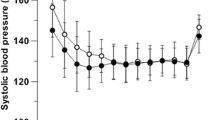Abstract
The effects of pulsatile cardiopulmonary bypass on the renin-angiotensin-aldosterone system and tissue metabolism, especially those which occur soon after surgery, were studied in 26 patients who required total cardiopulmonary bypass for longer than 60 minutes. These patients comprised 11 who underwent open heart surgery utilizing nonpulsatile cardiopulmonary bypass (Group I) and 15 who underwent open heart surgery utilizing pulsatile cardiopulmonary bypass (Group II). Plasma angiotensin II and serum aldosterene levels were significantly increased one and 5 hours postoperatively in Group I when compared with the preoperative values, whereas no significant elevations were observed in Group II. Plasma angiotensin II and serum aldosterone levels one hour postoperatively in Group II were significantly lower than those in Group I. Lactate levels in the arterial blood were significantly elevated, one and 5 hours postoperatively in both Groups I and II. Moreover, no significant difference was observed in the lactate levels between Groups I and II, one hour postoperatively. In the nonpulsatile group (Group I), plasma angiotensin II levels one hour postoperatively were correlated significantly with the duration of total cardiopulmonary bypass. In conclusion, pulsatile cardiopulmonary bypass offers significant advantages in terms of lower plasma angiotensin II and serum aldosterone levels, when compared with nonpulsatile cardiopulmonary bypass soon after open heart surgery requiring total cardiopulmonary bypass for longer than 60 minutes, however, it does not offer a definite advantage for tissue metabolism.
Similar content being viewed by others
References
Sancho J ReR, Burton J, Barger AC, Haber E. The role of the renin-angiotensin-aldosterone system in cardiovascular homeostasis in normal human subjects. Circulation 1976; 53: 400–405.
Curtiss C, Cohn JN, Vrobel T, Franciosa JA. Role of the renin-angiotensin system in the systemic vasoconstriction of chronic congestive heart failure. Circulation 1978; 58: 763–776.
Bailey DR, Miller ED Jr, Kaplan JA, Rogers PW. The renin-angiotensin-aldosterone system during cardiac surgery with morphine-nitrous oxide anesthesia. anesthesiology 1975; 42: 538–544.
Taylor KM, Morton IJ, Brown JJ, Bain WH, Caves PK. Hypertension and the renin-angiotensin system following openheart surgery. J Thorac Cardiovasc Surg 1977; 74: 840–845.
Taylor KM, Bain WH, Russell M, Brannan JJ, Morton IJ. Peripheral vascular resistance and angiotensin II levels during pulsatile and nonpulsatile cardiopulmonary bypass. Thorax 1979; 34: 594–598.
Trinkle JK, Helton NE, Wood RE, Bryant LR. Metabolic comparison of a new pulsatile pump and a roller pump for cardiopulmonary bypass. J Thorac Cardiovasc Surg 1969; 58: 562–569.
Jacobs LA, Klopp EH, Seamone W, Topaz SR, Gott VL. Improved organ function during cardiac bypass with a roller pump modified to deliver pulsatile flow. J Thorac Cardiovasc Surg 1969; 58: 703–712.
Frater RWM, Wakayama S, Oka Y, Becker RM, Desai P, Oyama T, Blaufox MD. Pulsatile cardiopulmonary bypass: Failure to influence hemodynamics or hormones. Circulation 1980; 62 (suppl I): 19–25.
Singh RKK, Barratt-Boyes BG, Harris EA. Does pulsatile flow improve perfusion during hypothermic cardiopulmonary bypass. J Thorac Cardiovasc Surg 1980; 79: 827–832.
Boucher JK, Rudy LW, Edmunds HJR. Organ blood flow during pulsatile cardiopulmonary bypass. J Appl Physiol 1974; 36: 86–90.
Haber E, Koener T, Page LB, Kliman B, Purnode A. Application of radioimmunoassay for angiotensin I to the physiologic measurements of plasma renin normal human subjects. J Clin Endocrinol Metab 1969; 29: 1349–1355.
Emanuel RL, Cain JP, Williams GH. Double antibody radioimmunoassay of renin activity and angiotensin II in human peripheral plasma. J Lab Clin Med 1973; 81: 632–640.
Farmen RW, Brown DH, Howard PY, Fabre LF Jr. A radioimmunoassay for plasma aldosterone without chromatography. J Clin Endocrinol Metab 1973; 36: 460–465.
Laudahn G. Ferinentaktivaten und Konzentration von Stoffwechselzwischenprodukten im Blut bei Leber- und Herzkrankheiten. Klin Wochr 1959; 37: 850–858.
Trinkle JK, Helton NE, Bryant LR, Briffen WO. Pulsatile cardiopulmonary bypass: Clinical evaluation. Surgery 1970; 68: 1074–1078.
Dunn J, Kirsk MM, Harmess J, Carroll M, Straker J, Sloan H. Hemodynamic, metabolic, and hematologic effects of pulsatile cardiopulmonary bypass. J Thorac Cardiovasc Surg 1974; 68: 138–147.
Philbin DM, Levine FH, Kono K, Coggins CH, Moss J, Slater EE, Buckley MJ. Attenuation of the stress response to cardiopulmonary bypass by the addition of pulsatile flow. Circulation 1981; 64: 808–812.
Landymore RW, Murphy DA, Kinley CE, Parrott JC, Moffitt EA, Longley WJ, Oirbi AA. Does pulsatile flow influence the incidence of postoperative hypertension? Ann Thorac Surg 1979; 28: 261–266.
Goodman AT, Gerard DF, Bernstein EF, Dilley RB. The effects of pulseless perfusion on the distribution of renal cortical blood flow and on renin release. Surgery 1976; 80: 31–38.
Favre L, Vallotton MB, Muller AB. Relationship between plasma concentrations of angiotensin I, angiotensin II and plasma renin activity during cardiopulmonary bypass in man. Europ J Clin Invest 1974; 4: 135–140.
Taylor KM, Casals JG, Mittra SM, Brannan JJ, Morton JJ. Haemodynamic effects of angiotensin converting enzyme inhibition after cardiopulmonary bypass in dogs. Cardiovasc Res 1980; 14: 199–205.
Cerletti A, Sturmen E, Konzette H. Bradykinin. Dtsch Med Wochr 1961; 86: 678–683.
Nagaoka H, Katori M. Inhibition of kinin formation by a kallikrein inhibitor during extracorporeal circulation in openheart surgery, Circulation 1975; 52: 325–332.
Shepard RB, Kirklin JW. Relation of pulsatile flow to oxygen consumption and other variables during cardiopulmonary bypass. J Thorac Cardiovasc Surg 1969; 58: 694–702.
Perez DI, McGregor M, Dossetor JB. Lactic acidosis: A clinically significant aspect of shock. Canad Med Ass J 1964; 90: 673–675.
Author information
Authors and Affiliations
Rights and permissions
About this article
Cite this article
Nagaoka, H., Innami, R. & Arai, H. Effects of pulsatile cardiopulmonary bypass on the renin-angiotensin-aldosterone system following open heart surgery. The Japanese Journal of Surgery 18, 390–396 (1988). https://doi.org/10.1007/BF02471462
Received:
Issue Date:
DOI: https://doi.org/10.1007/BF02471462




